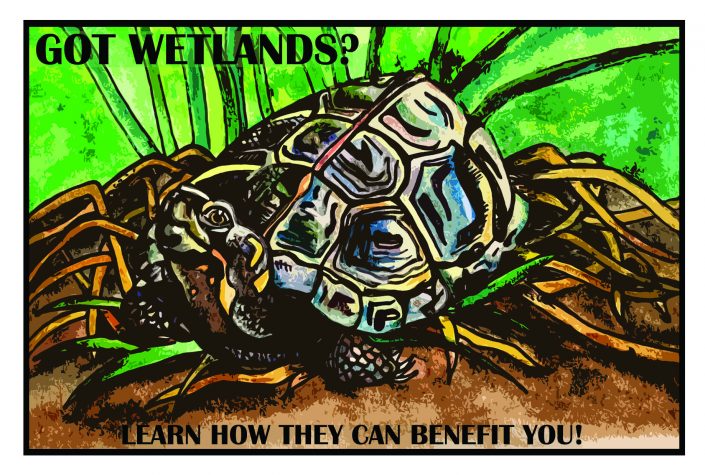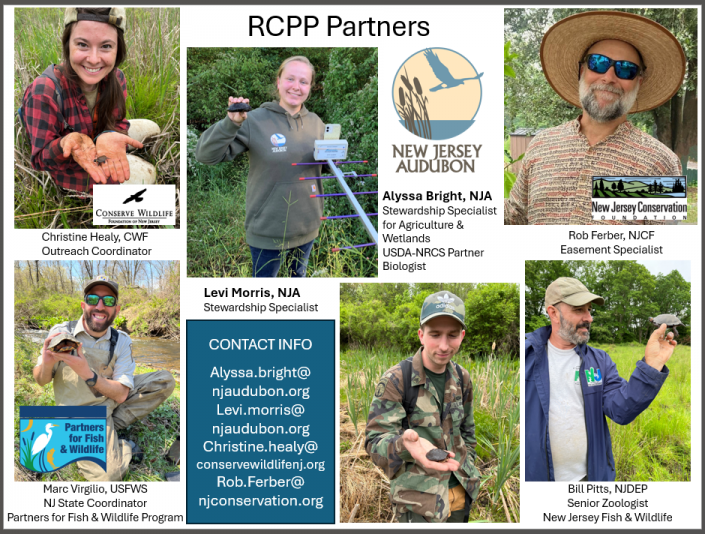Be the Disturbance You Wish to See in the Wetland
by Christine Healy, Wildlife Biologist
Since 2021, Conserve Wildlife Foundation of New Jersey (CWF) has been partnering with New Jersey Audubon (NJA), New Jersey Conservation Foundation (NJCF), the United States Fish and Wildlife Service (USFWS), and New Jersey Fish and Wildlife (NJFW) on bog turtle conservation in Salem County. Though densities in the southern part of the state are understood to be lower than in north Jersey, conserving this metapopulation is a priority as bog turtle numbers continue to decline despite long-term state (endangered since 1974) and federal (threatened since 1997) protections. A primary driver of this decline is habitat loss- but not necessarily in the way you might expect. The shift in plant communities- from grasslands to forests- occurs naturally over time. We call this process “succession”, and it can be both a gift and a curse.
Under normal circumstances, Mother Nature sometimes throws a wrench in the plans of mid- and late-successional species (like oaks and maples, respectively), in the form of disturbances. Beaver activity may cause flooding that inhibits tree growth. Natural fires in healthy forests can thin trees enabling the understory to receive enough sunlight to persist. These burn slower and cooler than wildfires. Some trees, like the longleaf pine in the southern US, even require fire in order to rejuvenate. In some cases, large mammals may eat or break saplings before they have a chance to establish. This apparent “destruction” is actually a good thing- disturbances like these are why we have meadows and prairies. A mosaic of habitat types that run the spectrum of open wetlands to old-growth forest, is key to a high diversity of wildlife.
Unfortunately, many of the aforementioned types of disturbance do not complement human lifestyles. We don’t like the flood risk created by beavers, especially when they occur close to developments, so we remove them. We fear fire so we suppress it, which has actually increased the likelihood and severity of wildfires over time. In New Jersey, we don’t have large (wild) grazers to set back succession. Further, we’ve been conditioned to believe that cutting trees is always bad. And so, succession continues unchecked, eliminating critical habitat for countless species, bog turtles included.
Bog turtles thrive in spring-fed fens and wet meadows with mucky soil, clean, slow-moving water, nice tussocks, and open canopies. During the heat of the day, they hunker down in the mud to stay cool and to protect themselves from predators. Their small size renders them easy pickings for more species than could normally chow down on adult turtles. They are also, to be brutally honest, very lazy parents. Females will deposit their eggs on clumps of vegetation and leave the work of incubation to the sun. It is because of this tendency that succession is such a problem for them.
Without all those natural forces to keep open wet meadows available to the species that need them, it is up to humans to (to paraphrase Gandhi) be the disturbance [we] wish to see in the wetlands. And that’s where our Salem County bog turtle project comes in.

This work, funded by the Natural Resources Conservation Service (NRCS) under a Regional Conservation Partnership Program (RCPP) grant provides funding for landowners in the Upper Salem River Watershed to institute practices that will enhance and preserve bog turtle habitat in an area that would normally get overshadowed by higher density north Jersey sites. RCPP is a voluntary Farm Bill initiative that can take one of two tracts; it can function as a cost-share to help applicants finance work that benefits the environment (or bog turtles, in the case of this specific RCPP) that they may have considered instituting anyway. Examples could include stream habitat improvement, wetland enhancement, or woody/herbaceous vegetation management using practices like prescribed grazing, planting cover crops and vegetative buffers, using reduced/no-till farming, and creating stream crossings for livestock. The other option is preservation in perpetuity, in the form of a wetland easement. Landowners who are interested in this track sell the developmental rights of the habitat to NRCS while retaining ownership and the right to passive enjoyment (hunting, fishing, hiking, birding, etc.).

This is a great opportunity for eligible Salem County residents to contribute to wildlife conservation while receiving some benefit in return.
Interested in learning more? Check out this informational webinar, hosted by CWF biologist, Christine Healy, and the rest of the RCPP team:
If you own property in the target area and want to chat about whether RCPP could be a good fit for you, reach out to Christine at Christine.healy@conservewildlifenj.org.
Discover more from Conserve Wildlife Foundation of NJ
Subscribe to get the latest posts sent to your email.